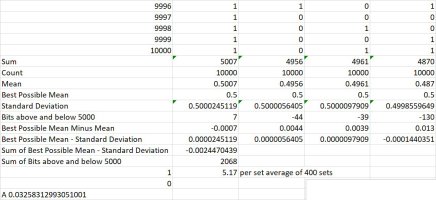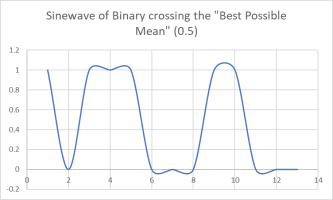The closer to “Best Possible Mean” and random is what the goal is. Therefore “Best Possible Mean” minus Standard Deviation is a concrete base for random, I believe. It gives a definitive way of working with random numbers.
Please explain
why you
believe this. Where did this idea come from? Mathematics is not a matter of something feeling right; if you don't have the background to
prove a claim, then you shouldn't make it.
But you still haven't said that you claim to be calculating. Are you saying you are calculating the
mean of all the random digits you get over, say, 10,000 repetitions, and
subtracting from that the
standard deviation of those digits? What do you do with that? Do you want to use that in some way to judge the randomness of your data?
How?
It's true that you would
expect the mean of the data to be about 0.5
over the long run; perhaps that's what you mean by "
best possible". There's also an expected value for the
standard deviation of the data in a uniform distribution. But I don't know why you would subtract that from the mean.
Have you studied enough probability theory to know how much variation to expect from that, if the data are random?
Without a base no further work can be done. What are you measuring each “random number generator” against the others ”random number generator.
This is what NIST is trying to do with the paper I linked to (for one particular application of random numbers, namely cryptography)). If you're saying no one should be making random numbers because there is no one standard, then you are being silly. And to try to propose a "standard" with no proof that it makes sense, and no clear description of exactly what you mean is even sillier.
Random binary will have a sinewave. This chart is not the best lay out, but it shows that there is a sinewave. The “Best Possible Mean” is in the middle. Sinewaves come in many different forms. Not always nice and smooth.
You don't know what a
sine wave is. It is strictly periodic, and has a very specific form. I think what you are talking about is a
periodic function of some sort; but random anything will by definition
not be periodic. It will vary randomly.
But, again,
on what grounds do you claim that it will "have a sine wave"?
As far as NIST information. I contacted NIST to get the “Standard for Random Number “, was informed there is no such thing! Only a set of math functions that are not definitive. I have them. Anyone can get them from NIST.
So you think something more can be said than they have said about defining what random means. Whether you think
you or
we can do that, why would you think it's a sensible thing to try to do?
The output of a generator satisfying these three properties will be good enough for a one-time pad, key generation, and any other cryptographic applications that require a truly random sequence generator.
This is what NIST is trying to make more precise. Have you read the paper, or other materials from them?




